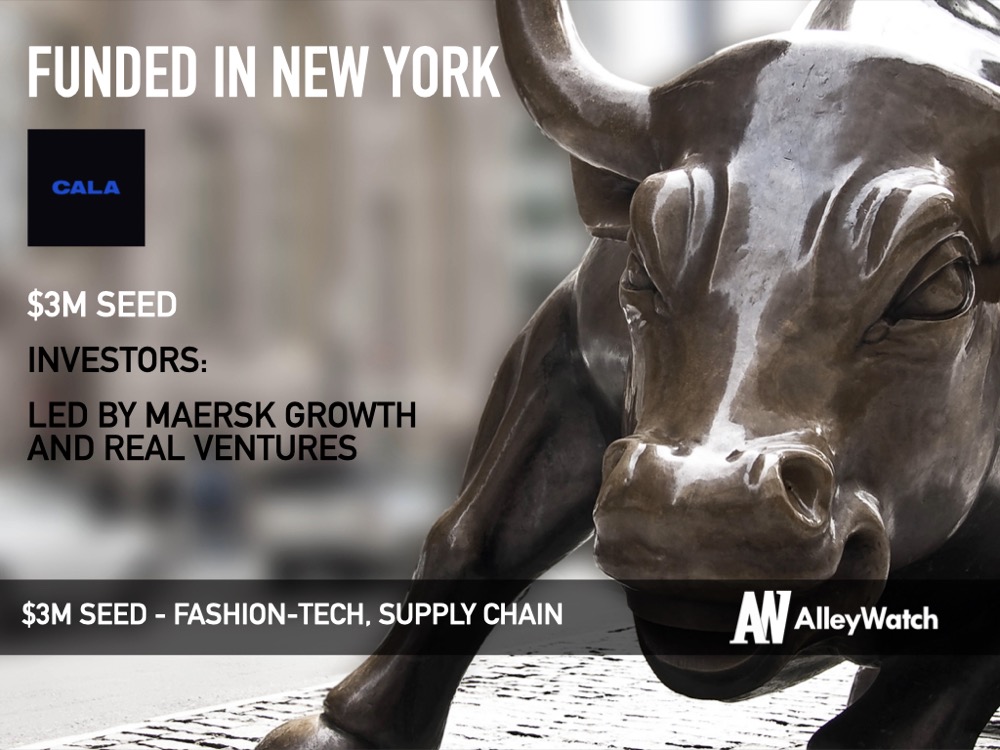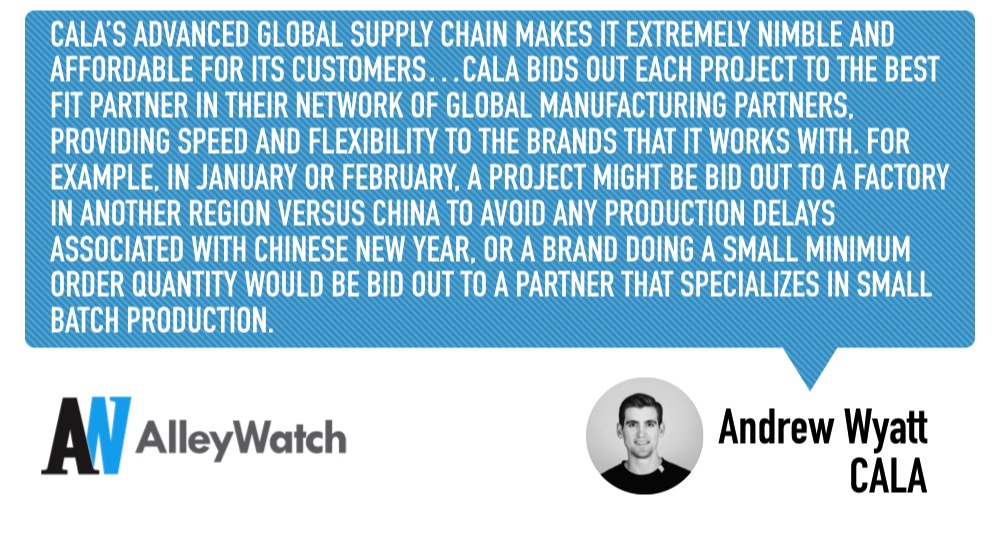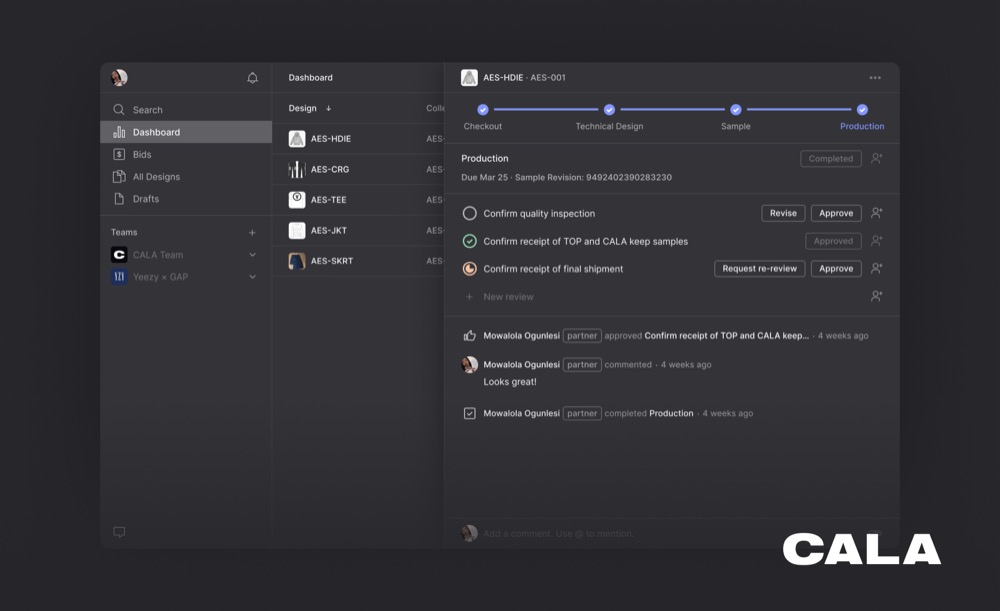Creating a fashion brand isn’t as glamorous as it may seem and there are so many moving parts. From sourcing fabrics to finding the right manufacturer, first-time founders can easily begin to wonder if they will ever see their designs hanging on a clothing rack and available for purchase. CALA is the end-to-end marketplace that helps fashion novices (many of whom are influencers with 500K+ following) create a fashion brand. Regardless of formal design experience, CALA’s digital platform allows clients to execute every step of the design process from start to finish (pattern, logos, material sourcing, production, distribution, and end-customer support). CALA also has a network of branding experts and ghost designers that can assist clients with anything from marketing strategy to designing the actual garment. As a fashion-tech startup, CALA has a pricing algorithm that dynamically responds to the global supply chain, so clients can get the best production costs from a network of vetted manufacturing. CALA has been used by rapper A$AP Ferg, NFL player Travis Kelce, and TV personality Colton Underwood for the launches of their own brands.
AlleyWatch caught up with CEO Andrew Wyatt to discuss the evolution of CALA, its plans for growth, and trends in the retail space. In the past three months, CALA has signed 20 new partnerships and produced over 75K garments across 500 unique apparel style; all in the middle of a global pandemic.
Who were your investors and how much did you raise?
$3M second Seed round co-led by Maersk Growth, the venture arm of shipping integrated container logistics company A.P. Moller-Maersk, and a leading early-stage venture capital firm Real Ventures.
Tell us about the product or service that CALA offers.
Founded in 2016, CALA is a managed marketplace that provides a plug and play infrastructure for creators to design and launch full scale, digital-first fashion brands, regardless of their level of formal design training. By digitizing and unifying the entire apparel supply chain, CALA users benefit from accelerated time to market, lower up-front costs, smaller order minimums, and more visibility into their projects.
What inspired the start of CALA? How is CALA different?
As a first employee at Shyp, I saw firsthand how creators were using new platforms (Shopify, Etsy, eBay, Instagram) and new tools/services (Shyp, Flexport, Shipwire) to launch businesses without the funding or headcount traditionally needed to do so. Despite the new digital marketplaces that were available to creators, many were still struggling because there was so much that they still needed to “figure out,” especially given that many of Shyp’s early customers were small fashion retailers. As I learned more about their particular pain points, it became apparent that these businesses needed a more managed, full-stack solution. CALA now serves fashion brands of all shapes and sizes, but Shyp’s earliest small-scale fashion customers became the inspiration for CALA.
CALA is unique in its approach to fashion design and manufacturing for several reasons:
CALA is a one-stop-shop for anyone looking to launch a clothing line. Using our platform someone can execute every step of the design process from start to finish – from the patterns or logos to material sourcing and finally the production, distribution, and end-customer support – CALA’s digital platform is a complete end-to-end solution. CALA also has an experienced network of consultants available to help clients with everything from graphic designing logos, branding, and marketing or ghost designers to help bring design inspiration to life. As part of their membership, CALA’s customers can take full advantage of these professional services, which can even include a designated Brand Director. In addition to providing the infrastructure to build a brand, CALA believes deeply in the accessibility to experts and educational materials required to be successful. Last month, CALA launched 1MOQ, a weekly newsletter and content archive providing tactical resources and industry commentary on how to build a successful fashion brand.
CALA’s advanced global supply chain makes it extremely nimble and affordable for its customers, especially in today’s day and age. CALA’s revolutionary pricing algorithm updates real-time based on the order quantity and enables designers to see the total landed cost for their designs. CALA bids out each project to the best fit partner in their network of global manufacturing partners, providing speed and flexibility to the brands that it works with. For example, in January or February, a project might be bid out to a factory in another region versus China to avoid any production delays associated with Chinese New Year, or a brand doing a small minimum order quantity would be bid out to a partner that specializes in small batch production.
What market does CALA target and how big is it?
CALA is targeting individuals that have built great audiences online and are looking to create a great fashion brand (or even just one-off products i.e. hats, scarves, limited edition apparel) that are authentic to them and their audience. There are more than 15M individuals that have an audience greater than 500K, so we think there’s a vast total available market (TAM).
We’re also helping existing brands and companies reduce costs by digitizing and streamlining operations.
What’s your business model?
We charge a monthly subscription fee, plus a percentage of sales.
How has COVID-19 impacted the business?
CALA’s digital-first platform combined with the global nature of its manufacturing network actually poised CALA for exponential growth over the past few months. CALA became a natural choice for people and brands that wanted to launch direct-to-consumer products, and we’ve signed 20 new partnerships in the past three months, producing over 75K garments across 500 unique apparel styles since January 2020. Some of CALA’s latest and most notable partnerships include NFL player Travis Kelce, hip hop artist KSI, Deena Nicole Cortese from The Jersey Shore, fashion model Tatiana Ringsby, Tabria Majors and Colton Underwood.
What was the funding process like?
Luckily, we already had a pre-existing relationship with Real Ventures. Real Ventures led our first Seed round, and they saw the potential for CALA’s continued growth and wanted to double down. We had also been excited about the prospect of partnering with Maersk Growth for some time, so we weren’t starting from zero in terms of net-new relationships.
What are the biggest challenges that you faced while raising capital?
The hysteria. As soon as San Francisco was ordered to shelter in place, we took a full day to talk to current or potential investors and review our financial plan. This early action coupled with great advice from existing investors optimized our business to navigate the uncertainties of the past few months.
What factors about your business led your investors to write the check?
Maersk is one of the most pivotal players in the global supply chain space, thus they have a unique foresight into many industries, including retail. I believe their investment in CALA signals they have been seeing the decrease in large wholesale orders and thus see CALA as the infrastructure for the new fashion/retail operating model.
Maersk is one of the most pivotal players in the global supply chain space, thus they have a unique foresight into many industries, including retail. I believe their investment in CALA signals they have been seeing the decrease in large wholesale orders and thus see CALA as the infrastructure for the new fashion/retail operating model.
What are the milestones you plan to achieve in the next six months?
We are in the process of aggressively expanding our partner network (manufacturers and consultants), so we can support at least 3X the number of clients we serve by the end of the year. We’re also seeing existing larger brands come to us because they are looking to shift to direct-to-consumer (DTC) and cut costs due to wholesale business evaporating overnight. Additionally, we’re constantly improving our product experience, so we have some exciting new features, partnerships, and integrations in the works to help us on our mission: empowering creators everywhere.
What advice can you offer companies in New York that do not have a fresh injection of capital in the bank?
Regardless of whether you have a fresh injection of capital or not, the most important thing to do right now is to focus on the 2-3 core metrics that drive the business. Nothing else matters. If you can show movement in those areas over the next 6 months you will one of two things:
- Profitable and irreplaceable – the goal.
- Have a great business that has withstood 2020, and thus be a great target for investors.
Where do you see the company going now over the near term?
We’re thinking a lot about how CALA and our Clients can partner together to use our platform for charitable causes on a recurring basis.
What’s your favorite outdoor dining restaurant in NYC
Mission Chinese Food! They also have great merch!
You are seconds away from signing up for the hottest list in New York Tech! Join the millions and keep up with the stories shaping entrepreneurship. Sign up today






